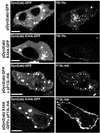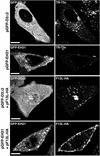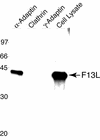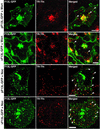Intracellular trafficking of a palmitoylated membrane-associated protein component of enveloped vaccinia virus
- PMID: 12885917
- PMCID: PMC167247
- DOI: 10.1128/jvi.77.16.9008-9019.2003
Intracellular trafficking of a palmitoylated membrane-associated protein component of enveloped vaccinia virus
Abstract
The F13L protein of vaccinia virus, an essential and abundant palmitoylated peripheral membrane component of intra- and extracellular enveloped virions, associates with Golgi, endosomal, and plasma membranes in the presence or absence of other viral proteins. In the present study, the trafficking of a fully functional F13L-green fluorescent protein (GFP) chimera in transfected and productively infected cells was analyzed using specific markers and inhibitors. We found that Sar1(H79G), a trans-dominant-negative protein inhibitor of cargo transport from the endoplasmic reticulum, had no apparent effect on the intracellular distribution of F13L-GFP, suggesting that the initial membrane localization occurs at a downstream compartment of the secretory pathway. Recycling of F13L-GFP from the plasma membrane was demonstrated by partial colocalization with FM4-64, a fluorescent membrane marker of endocytosis. Punctate F13L-GFP fluorescence overlapped with clathrin and Texas red-conjugated transferrin, suggesting that endocytosis occurred via clathrin-coated pits. The inhibitory effects of chlorpromazine and trans-dominant-negative forms of dynamin and Eps15 protein on the recycling of F13L-GFP provided further evidence for clathrin-mediated endocytosis. In addition, the F13L protein was specifically coimmunoprecipitated with alpha-adaptin, a component of the AP-2 complex that interacts with Eps15. Nocodazole and wortmannin perturbed the intracellular trafficking of F13L-GFP, consistent with its entry into late and early endosomes through the secretory and endocytic pathways, respectively. The recycling pathway described here provides a mechanism for the reutilization of the F13L protein following its deposition in the plasma membrane during the exocytosis of enveloped virions.
Figures








Similar articles
-
Role of receptor-mediated endocytosis in the formation of vaccinia virus extracellular enveloped particles.J Virol. 2005 Apr;79(7):4080-9. doi: 10.1128/JVI.79.7.4080-4089.2005. J Virol. 2005. PMID: 15767409 Free PMC article.
-
Movements of vaccinia virus intracellular enveloped virions with GFP tagged to the F13L envelope protein.J Gen Virol. 2001 Nov;82(Pt 11):2747-2760. doi: 10.1099/0022-1317-82-11-2747. J Gen Virol. 2001. PMID: 11602786
-
Similarities in the induction of post-Golgi vesicles by the vaccinia virus F13L protein and phospholipase D.J Virol. 2002 Aug;76(15):7777-89. doi: 10.1128/jvi.76.15.7777-7789.2002. J Virol. 2002. PMID: 12097590 Free PMC article.
-
Pox, dyes, and videotape: making movies of GFP-labeled vaccinia virus.Methods Mol Biol. 2004;269:205-18. doi: 10.1385/1-59259-789-0:205. Methods Mol Biol. 2004. PMID: 15114018 Review.
-
[Endocytic recycling pathways and the regulatory mechanisms].Yi Chuan. 2019 Jun 20;41(6):451-468. doi: 10.16288/j.yczz.19-124. Yi Chuan. 2019. PMID: 31257195 Review. Chinese.
Cited by
-
Respiratory syncytial virus F envelope protein associates with lipid rafts without a requirement for other virus proteins.J Virol. 2006 Dec;80(24):12160-70. doi: 10.1128/JVI.00643-06. Epub 2006 Sep 27. J Virol. 2006. PMID: 17005642 Free PMC article.
-
Differential role played by the MEK/ERK/EGR-1 pathway in orthopoxviruses vaccinia and cowpox biology.Biochem J. 2006 Aug 15;398(1):83-95. doi: 10.1042/BJ20060509. Biochem J. 2006. PMID: 16686604 Free PMC article.
-
Tagging of the vaccinia virus protein F13 with mCherry causes aberrant virion morphogenesis.J Gen Virol. 2017 Oct;98(10):2543-2555. doi: 10.1099/jgv.0.000917. J Gen Virol. 2017. PMID: 28933687 Free PMC article.
-
A vaccinia virus-driven interplay between the MKK4/7-JNK1/2 pathway and cytoskeleton reorganization.J Virol. 2012 Jan;86(1):172-84. doi: 10.1128/JVI.05638-11. Epub 2011 Oct 26. J Virol. 2012. PMID: 22031940 Free PMC article.
-
A Tyrosine-Based Trafficking Motif of the Tegument Protein pUL71 Is Crucial for Human Cytomegalovirus Secondary Envelopment.J Virol. 2017 Dec 14;92(1):e00907-17. doi: 10.1128/JVI.00907-17. Print 2018 Jan 1. J Virol. 2017. PMID: 29046458 Free PMC article.
References
-
- Barlowe, C., L. Orci, T. Yeung, M. Hosobuchi, S. Hamamoto, N. Salama, M. F. Rexach, M. Ravazzola, M. Amherdt, and R. Schekman. 1994. COPII: a membrane coat formed by Sec proteins that drive vesicle budding from the endoplasmic reticulum. Cell 77:895-907. - PubMed
-
- Benmerah, A., M. Bayrou, N. Cerf-Bensussan, and A. Dautry-Varsat. 1999. Inhibition of clathrin-coated pit assembly by an Eps15 mutant. J. Cell Sci. 112:1303-1311. - PubMed
MeSH terms
Substances
LinkOut - more resources
Full Text Sources
Other Literature Sources
Research Materials
Miscellaneous

